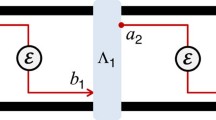Abstract
Based on the fundamental Holevo inequality and on the direct calculations, it is argued that the number of commitments required per one bit in a key in a damping channel increases exponentially with channel length. It is shown that the conclusion drawn recently by Duan et al. [4] that the exponential increase in resources for quantum cryptography in a damping channel can be reduced to the polynomial law by generating a through Einstein-Podolsky-Rosen pair is erroneous. Therefore, the results of [4] do not solve the fundamental problem restricting practical application of quantum cryptography at distances larger than the damping length.
Similar content being viewed by others
References
C. H. Bennett and G. Brassard, in Proceedings of IEEE International Conference on Computer Systems and Signal Processing, Bangalore, India, 1984, p. 175.
A. K. Ekert, Phys. Rev. Lett. 67, 661 (1991).
N. Gisin, G. Ribordy, W. Tittel, and H. Zbinden, quant-ph/0101098.
L.-M. Duan, M. Lukin, J. I. Cirac, and P. Zoller, quant-ph/0105105.
C. H. Bennett, Phys. Rev. Lett. 68, 3121 (1992); C. H. Bennett, G. Brassard, and N. D. Mermin, Phys. Rev. Lett. 68, 557 (1992).
A. S. Kholevo, Probl. Inf. Transm. 9, 177 (1973).
L. Goldenberg and L. Vaidman, Phys. Rev. Lett. 75, 1239 (1995); quant-ph/9506030.
S. N. Molotkov and S. S. Nazin, quant-ph/0008008; Pis’ma Zh. Éksp. Teor. Fiz. 73, 767 (2001) [JETP Lett. 73, 682 (2001)].
C. H. Bennett, P. W. Shor, J. A. Smolin, and A. V. Thapliya, quant-ph/0160052.
A. S. Holevo, quant-ph/0106075.
N. N. Bogolyubov, A. A. Logunov, A. I. Oksak, and I. T. Todorov, General Principles of Quantum Field Theory (Nauka, Moscow, 1987).
K. Kraus, States, Effects and Operations (Springer-Verlag, Berlin, 1983).
R. Laiho, S. N. Molotkov, and S. S. Nazin, Phys. Lett. A 275, 36 (2000); Phys. Lett. A 278, 9 (2000).
Author information
Authors and Affiliations
Additional information
__________
Translated from Pis’ma v Zhurnal Éksperimental’no\(\overset{\lower0.5em\hbox{$\smash{\scriptscriptstyle\smile}$}}{l} \) i Teoretichesko \(\overset{\lower0.5em\hbox{$\smash{\scriptscriptstyle\smile}$}}{l} \) Fiziki, Vol. 74, No. 10, 2001, pp. 580–585.
Original Russian Text Copyright © 2001 by Molotkov.
An erratum to this article is available at http://dx.doi.org/10.1134/1.1475725.
Rights and permissions
About this article
Cite this article
Molotkov, S.N. The efficiency of repeaters based on the Einstein-Podolsky-Rosen effect for quantum cryptography in a damping channel. Jetp Lett. 74, 517–521 (2001). https://doi.org/10.1134/1.1446547
Received:
Issue Date:
DOI: https://doi.org/10.1134/1.1446547




